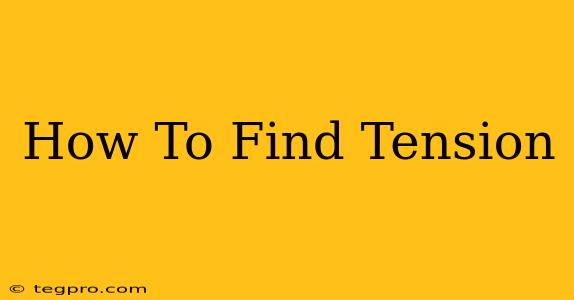Feeling stressed? Overwhelmed? Like you're constantly pulled in a million different directions? You might be experiencing tension. This guide will explore different types of tension, how to identify them, and practical steps to manage and alleviate them. Understanding and addressing tension is crucial for your physical and mental well-being.
Understanding Different Types of Tension
Tension isn't a one-size-fits-all experience. It manifests in various ways, impacting different aspects of your life.
1. Physical Tension:
This is the most easily recognizable type of tension. It involves the tightening of muscles, often resulting in:
- Headaches: Chronic tension headaches are a common symptom of physical tension.
- Muscle aches and pain: Neck pain, back pain, and shoulder pain are frequently linked to physical tension.
- Jaw clenching or grinding: This can lead to temporomandibular joint (TMJ) disorders.
- Fatigue: Constant muscle tension can drain your energy levels.
Identifying Physical Tension: Pay close attention to your body. Do you notice any stiffness, soreness, or discomfort? Are your muscles feeling tight or knotty? These are all signs of physical tension.
2. Mental Tension:
This type of tension is less visible but equally impactful. It involves feelings of:
- Anxiety: Constant worry and unease are hallmarks of mental tension.
- Stress: Feeling overwhelmed by demands and responsibilities.
- Overthinking: Ruminating on past events or worrying about future possibilities.
- Irritability: Feeling easily frustrated or angered.
Identifying Mental Tension: Notice your emotional state. Are you feeling anxious, stressed, or irritable? Do you find yourself constantly worrying or overthinking? These are indicators of mental tension.
3. Emotional Tension:
This involves suppressed or unexpressed emotions, leading to:
- Bottled-up feelings: Holding onto anger, sadness, or fear.
- Difficulty relaxing: Struggling to let go and unwind.
- Relationship problems: Tension in relationships can stem from unresolved emotional issues.
- Low self-esteem: Negative self-perception contributing to overall tension.
Identifying Emotional Tension: Reflect on your feelings. Are you suppressing any emotions? Do you find it difficult to express yourself openly? Are your relationships strained? These can point to underlying emotional tension.
Finding the Source of Your Tension
Pinpointing the root cause of your tension is crucial for effective management. Consider these factors:
- Lifestyle: Poor diet, lack of sleep, and insufficient exercise can contribute to tension.
- Work: Demanding jobs and stressful work environments are common sources of tension.
- Relationships: Conflict and unresolved issues with loved ones can lead to tension.
- Financial concerns: Money worries can significantly impact mental and emotional well-being.
- Health issues: Underlying medical conditions can exacerbate tension.
Techniques to Manage and Alleviate Tension
Once you've identified the type and source of your tension, you can implement strategies to manage and alleviate it.
Physical Tension Relief:
- Exercise: Regular physical activity helps release endorphins and reduce muscle tension. Yoga, Pilates, and stretching are particularly beneficial.
- Massage: Professional massage therapy can help relieve muscle tightness and knots.
- Heat or cold therapy: Applying heat or ice packs to tense muscles can provide relief.
Mental and Emotional Tension Relief:
- Mindfulness and meditation: These practices help calm the mind and reduce stress.
- Deep breathing exercises: Slow, deep breaths can help regulate your nervous system.
- Cognitive Behavioral Therapy (CBT): CBT can help identify and change negative thought patterns.
- Spending time in nature: Connecting with nature has a calming effect on the mind and body.
- Journaling: Writing down your thoughts and feelings can help process emotions and reduce tension.
- Seeking professional help: A therapist or counselor can provide support and guidance in managing tension.
Conclusion:
Finding and addressing tension requires self-awareness and a proactive approach. By identifying the types of tension you experience, understanding their sources, and utilizing effective coping mechanisms, you can significantly improve your physical and mental well-being. Remember, seeking professional help is a sign of strength, not weakness, and can be immensely beneficial in navigating challenging times.

